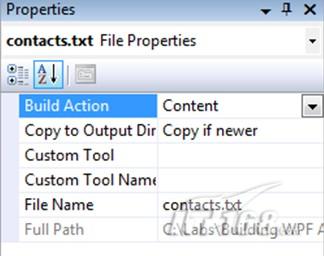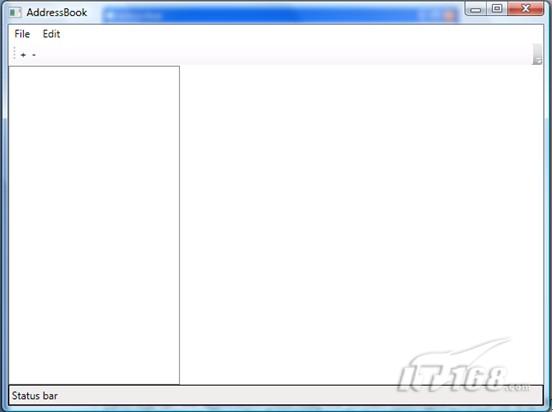详细解析WPF中的应用程序模型
创建一个WPF应用程序
使用WPF(Windows Presentation Foundation),您可以创建两种主要类型的应用程序:安装应用程序和 Web 浏览器的应用程序。两者之间的主要区别在于它们的托管方式,以及是否支持页面到页面之间的导航。Microsoft Visual Studio 2008为这两种应用都提供了模板。
在本实验室,我们将一起创建一个安装应用程序,最后将其通过ClickOnce或MSI部署安装到用户的操作系统,并托管在一个独立的窗口之中。这种类型的应用程序对最终用户的系统资源有完全访问权限,在部署之前也必须获得用户的许可。
1.创建基本应用
(1)启动Microsoft Visual Studio 2008
(2)使用C# “WPF Application”模板创建一个新项目。将其命名为’AddressBook’。这一步将搭建应用程序的基本骨架。
(3)地址簿应用程序会帮助您管理您的联系人。在项目中添加一个新的C#类。您可以通过Solution Explorer,在’AddressBook’项目上点击右键,选择Add?New Item,然后在对话框中选择'Class‘。我们将它命名为Contact.cs,并在文件里建立我们的数据模型:
using System.Collections.ObjectModel;
namespace AddressBook
{
/// <summary>
/// Contact value object
/// </summary>
public class Contact
{
/// <summary>
/// First name of contact
/// </summary>
public String FirstName
{
get;
set;
}
/// <summary>
/// Last name of contact
/// </summary>
public String LastName
{
get;
set;
}
/// <summary>
/// Email address of contact
/// </summary>
public String EmailAddress
{
get;
set;
}
/// <summary>
/// Home page
/// </summary>
public Uri HomePage
{
get;
set;
}
/// <summary>
/// Home address
/// </summary>
public string HomeAddress
{
get;
set;
}
/// <summary>
/// Business address
/// </summary>
public string BusinessAddress
{
get;
set;
}
}
/// <summary>
/// This collection will hold all of our contacts in the
/// address book
/// </summary>
public class ContactList : ObservableCollection<Contact>
{
public ContactList()
: base()
{
}
}
}
您会注意到ContactList这个类继承了ObservableCollection
(4)现在让我们定义联系人的集合。您需要在项目中添加一个新的文本文件contacts.txt。您可以通过Solution Explorer,右键点击项目,选择Add?New Item随后在对话框中选择’Text File‘。将以下内容复制到文件里:
Jane;Tester;jt@spaces.msn.com;http://spaces.msn.com;101 Baker St, Bellevue, WA 98055; 202 Smith St, Redmond, WA 98052
每行都是一个联系人的信息。一旦contacts.txt文件被创建,在Solution Explorer里选中它。文件的属性会出现在下方的Properties窗口。如果这个窗口没有出现,请右键点击这个文件,选择Properties。
·请注意Build Action这个属性的值是’Content’。这个值告诉WPF的MSBuild系统,把这个文件作为伴随应用程序的松散内容。
·Copy to Output Directory这个属性的值是’Do not copy‘,请把它改成’Copy if newer’。这一步确保一旦contacts.txt文件被修改了,新的版本会被复制到版本的输出目录里。

(5)为了控制应用程序启动和退出时的操作,我们下面要处理Application Startup和Exit事件。请在App.xaml.cs中添加下面的代码:
{
}
void AppStartup(object sender, StartupEventArgs args)
{
MainWindow mainWindow = new MainWindow();
mainWindow.WindowStartupLocation = WindowStartupLocation.CenterScreen;
mainWindow.Show();
}
private void AppExit(Object sender, ExitEventArgs e)
{
}
双击MyApp.xaml察看XAML,将以下标记语句添加到MyApp.xaml里,这样Startup事件就与代码绑定了。您需要删除StartupUri属性,以便由Startup事件的代码来处理MainWindow的加载工作。
x:Class="AddressBook.App"
xmlns:x="http://schemas.microsoft.com/winfx/2006/xaml"
xmlns="http://schemas.microsoft.com/winfx/2006/xaml/presentation"
StartupUri="MainWindow.xaml"
Startup="AppStartup"
Exit="AppExit" >
<Application.Resources>
</Application.Resources>
</Application>
(6)下面我们创建基本的UI。UI由一个Window组成,Window里有一个Grid并进一步包含一个DockPanel。DockPanel用来显示菜单栏,工具栏,状态栏,和一个罗列所有联系人的左面板。右边的面板则用来显示当前选中的联系人的详细信息。
在MainWindow.xaml文件里,我们从外层的Grid开始。首先将它命名为DocumentRoot:当您双击MainWindow.xaml时,您会同时看到Design选项卡和XAML选项卡。请选择XAML选项卡来编辑xaml:
xmlns="http://schemas.microsoft.com/winfx/2006/xaml/presentation"
xmlns:x="http://schemas.microsoft.com/winfx/2006/xaml"
Title="AddressBook"
Loaded="WindowLoaded"
SizeToContent="WidthAndHeight"
MinWidth="640"
MinHeight="480">
<Grid Background="White" Name="DocumentRoot">
<Grid.ColumnDefinitions>
<ColumnDefinition Width="200"/>
<ColumnDefinition Width="*"/>
</Grid.ColumnDefinitions>
<Grid.RowDefinitions>
<RowDefinition Height="Auto"/>
<!-- Menu -->
<RowDefinition Height="Auto"/>
<!-- Tool Bar -->
<RowDefinition Height="*"/>
<!-- Content Area -->
<RowDefinition Height="Auto"/>
<!-- Status Bar -->
</Grid.RowDefinitions>
</Grid>
</Window>
(7)我们所有的界面和UI元素都会放在DocumentRoot这个Grid里面。下面,我们创建一个DockPanel_Menu放菜单栏。顶层MenuItems有两个:File和Edit,每个菜单项都会包含若干子MenuItems:
<DockPanel
Name="DockPanel_Menu"
Grid.Column="0"
Grid.ColumnSpan="2"
Grid.Row="0">
<Menu Background="White">
<MenuItem Header="File">
<MenuItem Header="New Contact" Click="LaunchNewContactWizard"/>
<MenuItem Header="New Group" Click="NotImplementedMsg"/>
<Separator />
<MenuItem Header="Properties" Click="NotImplementedMsg"/>
<MenuItem Header="Delete" Click="NotImplementedMsg"/>
<MenuItem Header="Import">
<MenuItem Header="Address book (WAB)..."
Click="NotImplementedMsg"/>
<MenuItem Header="Business card vCard)..."
Click="NotImplementedMsg"/>
</MenuItem>
<Separator />
<MenuItem Header="Exit" InputGestureText="Alt-F4"
Click="ExitApplication">
<MenuItem.ToolTip>
<ToolTip>
Click here to exit
</ToolTip>
</MenuItem.ToolTip>
</MenuItem>
</MenuItem>
</Menu>
<Menu Background="White">
<MenuItem Header="Edit">
<MenuItem Command="ApplicationCommands.Copy"/>
<MenuItem Command="ApplicationCommands.Paste"/>
</MenuItem>
</Menu>
</DockPanel>
(8)下一步是工具栏。ToolBar有两个Buttons,允许您添加和删除联系人。我们稍后会实现添加的功能。至于删除,暂时由我们在上一步定义的NotImplementedMsg事件处理方法来处理。
<DockPanel
Name="DockPanel_Toolbar"
Grid.Column="0"
Grid.ColumnSpan="2"
Grid.Row="1">
<ToolBar>
<Button Click="LaunchNewContactWizard" ToolTip="Add Contact">
+
</Button>
<Button Click="NotImplementedMsg" ToolTip="Delete Contact">
-
</Button>
</ToolBar>
</DockPanel>
(9)左边的面板是这个地址簿应用程序的主要窗口,用来列出所有的联系人。我们使用ListBox,每个联系人的FirstName都是一个ListItem项。暂时让我们关注ListBox和DockPanel,稍后再回来看数据绑定。
既然看到这儿了,我们顺便为联系人列表定义一个上下文菜单。这样就可以添加一个联系人或者添加一个组了:
<DockPanel
Name="DockPanel_LeftPane"
Grid.Column="0"
Grid.Row="2">
<ListBox Name="allContacts" SelectionChanged="ListItemSelected">
<ListBox.ContextMenu>
<ContextMenu>
<MenuItem Header="Add a Contact" Click="LaunchNewContactWizard"/>
<MenuItem Header="Add a Group" Click="NotImplementedMsg"/>
</ContextMenu>
</ListBox.ContextMenu>
</ListBox>
</DockPanel>
(10)主窗口UI上另一个关键元素是状态栏。让我们在StatusBar元素里放置一个TextBlock:
<DockPanel
Name="DockPanel_Statusbar"
Grid.Column="0"
Grid.ColumnSpan="2"
Grid.Row="3">
<StatusBar
BorderBrush="Black"
BorderThickness="1">
<TextBlock Name="tb" Foreground="Black">
Status bar
</TextBlock>
</StatusBar>
</DockPanel>
(11)最后是右手边的窗口框。在左边ListItems显示之后,选择一条联系人,就会在右手边的这个Frame_RightPane里显示这个联系人的详细信息:
<Frame Name="Frame_RightPane"
Grid.Column="1"
Grid.Row="2"/>
(12)到此为止,我们已经在XAML里完成了UI元素的添加,是时候看看后面的代码了。在MainWindow.xaml.cs文件里,为MainWindow这个类添加ExitApplication,NotImplementedMsg,WindowLoaded,ListItemSelected和LaunchNewContactWizard方法。您会注意到后三个方法的实现是空的。我们稍后再添加这部分逻辑。
// Triggered on Window load. Sets the ContactList collection
// as the Data Context.
//
private void WindowLoaded(object sender, RoutedEventArgs e)
{
}
//
// Triggers application shutdown
//
void ExitApplication(object sender, RoutedEventArgs e)
{
this.Close();
}
//
// Shows a message box informing user that a feature
// hasn't been implemented.
//
void NotImplementedMsg(object sender, RoutedEventArgs e)
{
MessageBox.Show("This feature has not been implemented.",
"Not Implemented");
}
//
// Triggered when an item in the Contacts list is selected
//
void ListItemSelected(object sender,
SelectionChangedEventArgs args)
{
}
//
// Triggered when context menu or other toolbar option
// is clicked to launch
// 'Create a new contact' dialog
//
private void LaunchNewContactWizard(object sender,
RoutedEventArgs e)
{
}
(13)生成并运行您的应用程序。地址簿应用程序的基本框架已经搭好了。因为我们尚未初始化或使用联系人的信息,您在程序的左右面板上不会看到任何数据。在这一步,您的应用程序看上去是这样的:

2. 使用Property Bag来存储联系人的集合
(1)在程序启动的时候,应用程序必须从文件中读出联系人的信息,并初始化ContactList对象。打开App.xaml.cs文件并编辑。ReadContactsFromFile方法会从文件中读出数据。在类里添加这个方法,并添加一个辅助方法来把数据转化成联系人对象:
// Reads contact information from file
//
private ContactList ReadContactsFromFile()
{
ContactList contactList = new ContactList();
// Create an instance of StreamReader to read from a file.
// The using statement also closes the StreamReader.
using (StreamReader sr = new StreamReader("contacts.txt"))
{
String line;
// Read and display lines from the file until the
// end of the file is reached.
while ((line = sr.ReadLine()) != null)
{
contactList.Add(CreateContactFromLine(line));
}
}
return contactList;
}
//
// De-tokenize one line of contact information and
// hydrate a Contact object
//
private Contact CreateContactFromLine(string line)
{
string[] tokens = line.Split(new char[] { ';' });
if (tokens.Length != 6)
{
throw new ApplicationException(
String.Format("Input contact file format. " +
"Expected tokens {0}; Actual tokens {1}", 6,
tokens.Length));
}
Contact contact = new Contact();
contact.FirstName = tokens[0];
contact.LastName = tokens[1];
contact.EmailAddress = tokens[2];
contact.HomePage = (String.IsNullOrEmpty(tokens[3]) ?
null :
new Uri(tokens[3], UriKind.Absolute));
contact.HomeAddress = tokens[4];
contact.BusinessAddress = tokens[5];
return contact;
}
ReadContactFromFile方法使用System.IO.StreamReader。请确认您在命名空间声明处使用了System.IO:
using System.IO;
(2)下面我们把ReadContactsFromFile方法返回的ContactList数据,添加到应用程序Property Bag里面。如下修改AppStartup方法:
// Triggered on application startup. Positions the window,
// Initializes the contact list model and adds it to the
// Property Bag.
//
void AppStartup(object sender, StartupEventArgs args)
{
// initialize the Contacts collection using data from file
ContactList contactList = ReadContactsFromFile();
// add it to the Property Bag
this.Properties["ContactList"] = contactList;
MainWindow mainWindow = new MainWindow();
// make sure the window appears in the center of the screen
mainWindow.WindowStartupLocation =
WindowStartupLocation.CenterScreen;
mainWindow.Show();
}
(3)让我们顺便在这里创建一个方法,来把联系人数据的更新存回到contacts.txt文件里。因为逻辑非常简单且与本实验关系不大,我们这里就不去实现它了:
// Persists changes from ContactList object in Property Bag
// to file.
//
private void SaveContactsToFile(string fileName)
{
}
(4) 生成并运行应用程序。此时的UI看上去应该和上一个任务结束时没什么不同,看上去我们好像没有什么进展。别着急!
转自:http://tech.sina.com.cn/s/2009-12-04/07281160468.shtml


【推荐】国内首个AI IDE,深度理解中文开发场景,立即下载体验Trae
【推荐】编程新体验,更懂你的AI,立即体验豆包MarsCode编程助手
【推荐】抖音旗下AI助手豆包,你的智能百科全书,全免费不限次数
【推荐】轻量又高性能的 SSH 工具 IShell:AI 加持,快人一步
· 如何编写易于单元测试的代码
· 10年+ .NET Coder 心语,封装的思维:从隐藏、稳定开始理解其本质意义
· .NET Core 中如何实现缓存的预热?
· 从 HTTP 原因短语缺失研究 HTTP/2 和 HTTP/3 的设计差异
· AI与.NET技术实操系列:向量存储与相似性搜索在 .NET 中的实现
· 10年+ .NET Coder 心语 ── 封装的思维:从隐藏、稳定开始理解其本质意义
· 地球OL攻略 —— 某应届生求职总结
· 提示词工程——AI应用必不可少的技术
· Open-Sora 2.0 重磅开源!
· 周边上新:园子的第一款马克杯温暖上架